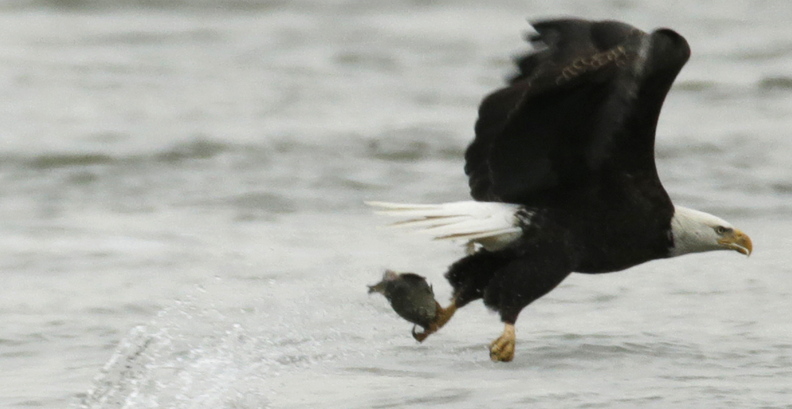WASHINGTON — The Obama administration said Friday it will allow some companies to kill or injure bald and golden eagles for up to 30 years without penalty, an effort to spur development and investment in green energy while balancing its environmental consequences.
The change, requested by the wind energy industry, will provide legal protection for the lifespan of wind farms and other projects for which companies obtain a permit and make efforts to avoid killing the birds.
An investigation by The Associated Press earlier this year documented the illegal killing of eagles around wind farms, the Obama administration’s reluctance to prosecute such cases and its willingness to help keep the scope of the eagle deaths secret. The White House has championed wind power, a pollution-free energy intended to ease global warming, as a cornerstone of President Obama’s energy plan.
In other areas, too, such as the government’s support for corn-based ethanol to reduce U.S. dependence on gasoline, the White House has allowed the green industry to do not-so-green things. Another AP investigation recently showed that ethanol has proven far more damaging to the environment than politicians promised and much worse than the government admits today.
Under the change announced Friday, companies would have to commit to take additional measures if they kill or injure more eagles than they have estimated they would, or if new information suggests that eagle populations are being affected. The permits would be reviewed every five years, and companies would have to submit reports of how many eagles they kill. Now such reporting is voluntarily, and the Interior Department refuses to release the information.
“This is not a program to kill eagles,” said John Anderson, the director of siting policy at the American Wind Energy Association. “This permit program is about conservation.”
Wind farms are clusters of turbines as tall as 30-story buildings, with spinning rotors as wide as a passenger jet’s wingspan. Though the blades appear to move slowly, they can reach speeds of up to 170 mph at the tips, creating tornado-like vortexes.
Flying eagles behave like drivers texting on their cellphones; they don’t look up. As they scan below for food, they don’t notice the industrial turbine blades until it is too late.
No wind energy company has obtained permission authorizing the killing, injuring or harassment of eagles, although five-year permits have been available since 2009. That puts the companies at legal risk and discourages private investment in renewable energy.
It also doesn’t necessarily help eagles, since without a permit, companies are not required to take steps to reduce their impact on the birds or report when they kill them.
The new rule makes clear that revoking a permit – which could undermine investments and interest in wind power – is a last resort under the administration’s energy policy.
“We anticipate that implementing additional mitigation measures … will reduce the likelihood of amendments to, or revocation of, the permit,” the rule said.
Conservation groups, which have been aligned with the wind industry on other issues, said the decision by the Interior Department sanctioned the killing of an American icon.
“Instead of balancing the need for conservation and renewable energy, Interior wrote the wind industry a blank check,” said Audubon President and CEO David Yarnold in a statement. The group said it will challenge the decision.
The wind energy industry has said the change mirrors permits already in place for endangered species, which are more at risk than bald and golden eagles. Bald eagles were removed from the endangered species list in 2007 but are still protected under two federal laws.
The regulation published Friday was not subjected to a full environmental review because the administration classified it as an administrative change.
Copy the Story LinkSend questions/comments to the editors.



Success. Please wait for the page to reload. If the page does not reload within 5 seconds, please refresh the page.
Enter your email and password to access comments.
Hi, to comment on stories you must . This profile is in addition to your subscription and website login.
Already have a commenting profile? .
Invalid username/password.
Please check your email to confirm and complete your registration.
Only subscribers are eligible to post comments. Please subscribe or login first for digital access. Here’s why.
Use the form below to reset your password. When you've submitted your account email, we will send an email with a reset code.